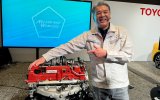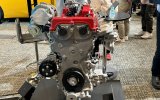
トヨタ、新型2.0リッターと1.5リッターエンジン公開 新型2.0リッターターボは600馬力を見すえた400馬力級スポーツエンジン
トヨタ自動車は5月28日、スバル、マツダとともに「マルチパスウェイワークショップ」を開催。そのなかで、新型2.0リッター4気筒ターボエンジンに加え、新型1.5リッターターボ&自然吸気エンジンの3種類のエンジンを開発中であることを明らかにした。
Holy shiet, the 2.0l turbo makes 400hp! Also they are turning back on their engines having a really long stroke and going to shorter stroke bigger bore engines, like these long stroke engines are so tall that it's difficult to package into cars with low hood lines, which is problematic if they want to make cars with sleek looking designs.






